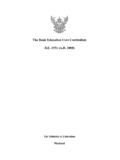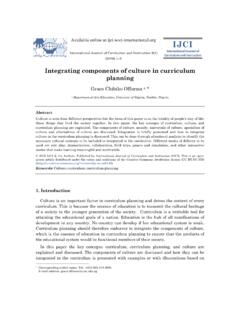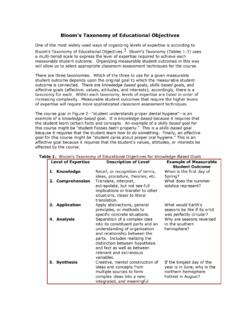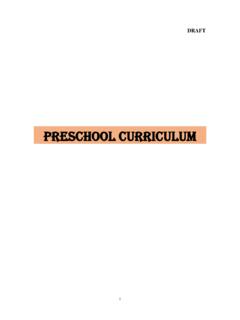Transcription of introduction to Curriculum Development in Nursing …
1 Part iintroduction to Curriculum Development in Nursing Education: the Evidence-informed, Context-relevant, Unified Curriculum 120/05/14 5:53 PM Jones & Bartlett Learning, LLC. NOT FOR SALE OR 220/05/14 5:53 PM Jones & Bartlett Learning, LLC. NOT FOR SALE OR DISTRIBUTIONC reation of an Evidence-Informed, Context-Relevant, Unified Curriculum Chapter OverviewCurriculum Development in Nursing education is a scholarly and creative process intended to produce an evidence-informed, context-relevant, unified Curriculum . It is an ongoing activity in Nursing education, even in schools of Nursing with established curricula. The extent of the Development ranges from regular refinement of class activities and assignments to the creation of a completely original and reconceptualized Curriculum . In this text, Curriculum Development activities are presented individually for ease of description and comprehension.
2 However, emphasis is on the idea that the Curriculum Development process does not occur in ordered, sequential stages or phases. The process is iterative, with some work occurring concurrently, and with each new decision having the potential to affect previous ones. This chapter begins with definitions of Curriculum , and an evidence-informed, context-relevant, unified Curriculum , followed by a description of Curriculum Development in Nursing education. The Model of Evidence-Informed, Context-Relevant, Unified Curriculum Development is presented. It comprises a summary of the major aspects of the Curriculum Development process, serving as an advance organizer for this text. Additionally, attention is given to some of the interpersonal issues that can influence the Curriculum Development team, and hence, the completed work. The ideas about the Curriculum Development process introduced in this chapter are discussed more comprehensively in succeeding goals Review definitions and conceptualizations of Curriculum .
3 Ponder the meaning of Curriculum as evidence-informed, context-relevant, and unified. Consider processes to enhance the scholarly nature of Curriculum Development . Overview the Model of Evidence-Informed, Context-Relevant, Unified Curriculum Development in Nursing Education Appreciate the interpersonal aspects of Curriculum 320/05/14 5:53 PM Jones & Bartlett Learning, LLC. NOT FOR SALE OR DISTRIBUTIOND efinitiOns anD COnCeptualizatiOns Of CurriCulumDefinitions of Curriculum have been in existence since about 1820, first used in Scotland and then professionally in America a century later (Wiles & Bondi, 2007). The word comes from the Latin currere, to run, or to run a course (Wiles & Bondi, 2011), and origi-nally meant the knowledge passed from one generation to the next (Wiles, 2005). A com-mon understanding of Curriculum is a program of studies with specified courses, leading to an academic certificate, diploma, or degree.
4 There have been so many definitions, often in response to social forces, that the scope and interpretation of Curriculum have greatly expanded, creating some uncertainty and divergence of opinion about the meaning and intent of the word. However, definitions are important, because they convey educators perceptions, and in turn, these perceptions affect how a Curriculum is used and indeed, even whether it is used at all (Hensen, 2010, p. 9). Additionally, the definition specifies the scope of work to be completed by curricu-lum developers (Wiles & Bondi, 2011). Oliva (2009) defines Curriculum as: A plan or program for all the experiences that the learner encounters under the direction of the school. In practice, the Curriculum consists of a number of plans, in written form and of varying scope and detail that delineate the desired learning experiences. The Curriculum , therefore, may be a unit, a course, a sequence of courses, the school s entire program of studies and may be encountered inside or outside class or school when directed by the personnel of the school.
5 (p. 7) Another perspective of Curriculum is a desired goal or set of values that can be acti-vated through a Development process, culminating in experiences for learners (Wiles & Bondi, 2011, p. 5). These authors go on to state that the extent to which the experiences rep-resent the envisioned goals is dependent on the effectiveness of the Curriculum developers. Parkay, Anctil, and Hass (2010) provide a broader description and give attention to the idea of theoretical and research bases for is all of the educational experiences that learners have in an educational program, the purpose of which is to achieve broad goals and related specific objectives that have been developed within a framework of theory and research, past and present professional practice, and the changing needs of society. (p. 3)They explain that: The Curriculum is preplanned and based on information from many sources.
6 objectives and instructional planning should be based on theory and research about society, human Development , and CHapter 1 / Creation of an evidence-informed, Context-relevant, unified Curriculum 420/05/14 5:53 PM Jones & Bartlett Learning, LLC. NOT FOR SALE OR DISTRIBUTION Curriculum decisions should be based on criteria. Students play an important role in the experienced Curriculum . Many other conceptualizations exist: a written document, planned experiences, a reflection of social emphases, planned learning outcomes, hidden or visible, and living or dead (Hensen, 2010). Hensen summarizes these definitions and interpretations into three categories: means versus ends, content versus experiences, and process versus plan. Oliva (2009) also reduces the many views of Curriculum to three categories. Some focus on pur-pose, what the Curriculum does or is meant to achieve; the context in which the Curriculum is implemented, possibly revealing the underlying philosophy, such as a learner-centered Curriculum ; and strategy or particular instructional or learning processes.
7 Somewhat simi-larly, Wiles (2005) categorizes definitions according to the emphasis on Curriculum as subject matter, a plan, an experience, or outcomes. Lunenberg (2011) offers a category that is markedly different from those previously described: the nontechnical approach. This refers to ideas about Curriculum that are more esthetic, emotional, political, and visionary, and less concerned with the how-to of Curriculum Development , implementation, and evaluation. For example, Diekelmann and Diekelmann (2009) propose a phenomenological, interpretative approach, termed narrative pedagogy, in which storytelling is the basis for interpretation and learning. The stimulation of thinking, not content, is at the heart of teacher activity. Freire (1970/2001) views education as a process of conscientization, the Development of criti-cal awareness of one s social reality through reflection and action, and Curriculum as the creation of knowledge by learners and teachers together, within the context of their lives (Freire, 1998).
8 Attention to political, social, gender, and/or personal perspectives is strongly evident in views such as critical pedagogy (Giroux, 2011), feminist pedagogy (Crawley, Lewis, & Mayberry, 2008; Shrewsbury, 1997), and transformative learning (Mezirow, Taylor, & Associates, 2009). The premises of the nontechnical approaches can overlap and may be combined, as exemplified in critical feminist pedagogy (Chow, Fleck, Fan, Joseph, & Lyter, 2003), often extending to include matters of race, culture, and sexuality. In descriptions of these education and learning approaches, attention is given to the underlying philosophies and to the processes of personal transformation, dialogue, reflection, inclusion, and democracy that should occur within and among stu-dents and teachers. The logistics of a formal Curriculum , such as course sequencing, are not the focus of nontechnical Curriculum approaches, although in professional pro-grams, such as Nursing , the nontechnical approaches can be used within the structure of a formal Curriculum .
9 Finally, Joseph (2011) views Curriculum much more broadly than any of the previous descriptions. She conceptualizes Curriculum as culture with complex sociopolitical, Definitions and Conceptualizations of 520/05/14 5:53 PM Jones & Bartlett Learning, LLC. NOT FOR SALE OR DISTRIBUTION political, and ethical layers of meaning (p. 3), and recognizes that many cultures can exist simultaneously within an educational setting. Because Curriculum is a process for trans-forming educational aims and practices (p. 3), it requires inquiry and introspection. Despite differing definitions and conceptions, a formal Curriculum is implemented with the intention that learning occurs. In professional programs, there is a written plan that usually contains philosophical statements and goals ; indicates some selection, organi-zation, and sequencing of subject matter and learning experiences; and integrates evalua-tion of learning.
10 These elements, among others, are addressed as aspects of the Curriculum Development process in subsequent chapters. Nursing Curriculum as evidence-informed, Context-relevant, and unifiedIn this text, Nursing Curriculum is defined as the totality of the philosophical approaches, Curriculum goals , overall design, courses, strategies to ignite learning, delivery methods, interactions, learning climate, evaluation methods, Curriculum policies, and resources. The Curriculum includes all matters that affect Nursing students learning and progression and that are within the authority of the school of Nursing . This conceptualization aligns with ideas of Curriculum as a plan, experiences, process, means, strategy, and as being visible. Evidence-informedA Curriculum that is evidence-informed is based on systematically and purposefully gath-ered evidence about: The context in which the Curriculum will be offered and graduates will practice Nursing Students, learning, teaching, and Nursing education Nursing practice Clients and their responses to health situations The evidence that is gathered is then subject to the interpretation of Curriculum developers.
















